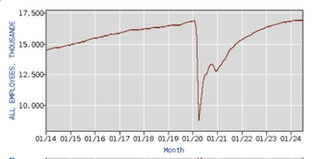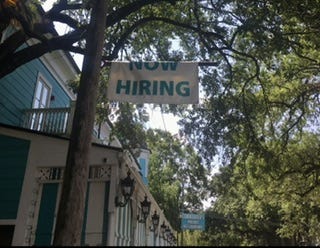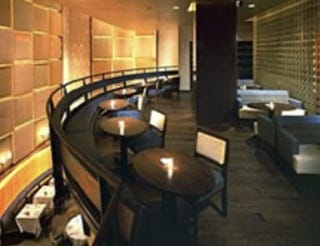The Big Concern Facing Restaurant Owners Now
Another headache on top of higher costs for food, rent and other factors
Welcome to the CulinaryWoman Newsletter. A special welcome to our newest subscribers and thank you to everyone who’s returning this week.
I’m especially happy to see people who found me through Threads. I pulled the plug on my Twitter account last week, and I’m now using Threads for daily social media. You can find me there (@) MichelineMaynard. Find more ways to contact me below.
I want to express my gratitude to those of you who donated to a food charity in honor of my birthday. Please keep them in mind as you figure out your charitable giving for the rest of the year.
The Red Warning Light On Restaurants’ Dashboard
I know peoples’ budgets are squeezed, and that everyone is being hit by higher costs. That’s particularly true in the restaurant business, where one expense in particular is hitting hard.
During the pandemic, restaurant staffing levels plummeted across the country, as you can see from this chart. Owners everywhere from fast food to elegant restaurants hung out Help Wanted signs.
To entice employees to come back, they raised pay and offered benefits like health care that hadn’t routinely been available.
Now, after nearly five years, employment levels in hospitality are back to pre-Covid figures. But there is a big red warning triangle glowing for the industry: wages.
In California, fast food employees now must earn $20 an hour. Michigan’s Supreme Court, meanwhile, has cleared the way for the state to eliminate servers’ tipped wages in favor of paying them a full minimum wage. That step was authorized by a statewide ballot proposal in 2018, but the restaurant industry fought it for years.
Now, that higher pay is prompting fears of more closures on top of a long list so far this year, and it won’t only be chains like Rubio’s, Red Lobster, Hooters and Buca di Beppo that leave the scene. It will be independent places, too.
Staffing levels stall
In 2019, there were 703,000 restaurants, ranging from fast food to full-service, in the United States, according to Technomic, a restaurant research firm. In the height of the pandemic, about 90,000 closed. Now, the country has about 749,000 restaurants, meaning the industry has recovered those losses and grown.
However, there was an eye-opening number this spring in the employment figures from the Bureau of Labor Statistics. After months in which hospitality jobs rose, they suddenly went flat in June. Up north, that seems incredible, since summer is one of the busiest times of the year in cities and resort area.
Not so in the South, where residents often flee for cooler places, and tourists are less likely to visit. The past couple of summers have been especially difficult in New Orleans and other hot weather towns. If you can visit, you’ll find food and drink specials all over town.
Employment bounced back a little in July, but the higher wage rates are serving as a giant red dashboard warning triangle for the industry.
As a long-time union member, I’m definitely in favor of people earning a living wage, and a number of communities actually have instituted living wage ordinances requiring hourly employees to be paid $20 or more, reflecting local costs.
A look at tipped wages
But the restaurant world by and large operates on a different tipped wage system, which has been in place since 1966.
Under it, restaurant employees can be paid less than the minimum wage, with the presumption that tips will top them up at least to the minimum wage, if not more.
Originally, the law required employers to pay tipped employees half of the federal minimum wage. However, the basic tipped wage was subsequently frozen at $2.13 an hour, more than 25 years ago.
States can pay the federal tipped wage rate or set their own higher rate. Alabama, Louisiana, Mississippi, South Carolina, and Tennessee pay the federal minimum. Forty-five states pay more.
Until this year, Michigan’s tipped wage was $3.84. It rose to $3.93 in January, and there will be a steady series of increases over the next four years until the tipped wage matches the state’s minimum wage (which is set to reach $13.50 an hour by then).
Voters approved the step six years ago, but the Republican controlled state legislature amended the law implementing the ballot proposal to slow the rollout. Proponents sued, saying that ballot proposals had to be implemented in the form that voters approved. The court agreed.
Now, the Michigan Restaurant & Lodging Association says it will try to reverse the court’s action with new legislation. It contends that owners and servers actually prefer the tipped wage system, and that any changes to it have to be implemented much more gradually than the ballot proposal required.
“This is an existential, all-hands-on-deck moment for our industry. To keep our industry from keeling over, we must band together to make our voice heard loud and often,” the association says on its website.
If the only issue was higher wages, restaurants might be able to adjust, an owner told me last week. After all, restaurants raised wages during the pandemic, when employees quit rather than be exposed to the virus.
But the industry is being hit with a tsunami of higher rents, higher food costs, higher utility bills, vandalism, and the danger from Covid lingers. Meanwhile, many consumers have cut back on dining out, save for special occasions or vacations.
An occasional treat versus a regular outing
Like new cars and trucks, dining out is becoming a purview of the wealthy.
Nationally, only diners from households earning over $200,000 a year spent money in restaurants more often in 2023 than they did in 2019, according to data from Circana, a organization that tracks consumer trends. Diners from families earning below $45,000 with kids pulled back on their restaurant spending the most, Circana found.
The average cost of a meal out at a fine-dining restaurant was $47.73 per person in 2023, up from $41.18 in 2019, according to Circana. The average price of a meal at a fast-food restaurant increased from $5.93 in 2019 to $7.63 in 2023. Eating at a fast casual restaurant cost $16.53 per person on average in 2023, up from $13.73 in 2019.
No wonder we’re seeing restaurants and food chains jump in with discount deals. They might attract more customers in the short run. But there are still big cost issues to deal with long term.
Pete Wells Says Things Have Changed And He Doesn’t Like It
New York Times restaurant critic Pete Wells wrote his farewell column last week. He compared the current restaurant landscape to the way things were when he began reviewing restaurants 12 years ago. His main take away was that service has changed for the worse, not the better.
Technology, like point of sale devices and touch screens, has “gradually and steadily stripped the human touch and the human voice out of restaurants,” Pete wrote. “Each of these changes was small, but together they’ve made going out to eat much less personal.”
In his earliest years writing reviews, “…We talked with hosts, bartenders, captains, runners and bussers. Being served in a restaurant wasn’t passive. We had to participate.”
He went on, “Many of the little routines of dining that we used to handle by talking to a person now happen on a screen.”
Pete listed other complaints, too, like influencers visiting a restaurant only to take photos of their food, the inability to call for a reservation now that reservations apps abound, and tasting menus where everybody gets the same thing.
A snarky comment below the column on social media likened it to the old man shouting at a cloud. That’s a little harsh, but I have to disagree on a couple of his points.
First of all, before reservation technology, restaurants often did not treat women, solo diners and people of color as well as they should. If you walked in and someone didn’t like your looks, you could be left dangling for a maitre d’ to grant you entrance.
Moreover, in-person service has never been consistent. Many diners complain of being ignored by servers once the food is dropped off, and have had to track down a manager to get their check.
Screens have made it possible for us to get exactly what we want, assuming customization is available as an option. Delivery app screens let us see what we’re going to pay in advance and to cancel or change the order if we’re going over our budget.
Moreover, hand-held devices allow you to pay, tip and depart. They save the server endless steps walking to and from the register to the table.
As for people visiting just for a viral moment, a friend and I had dinner at a hot New York City restaurant called Town, soon after it opened in 2001. (You might remember seeing it in Sex and the City.) We snagged a table on a Sunday night, and squeezed ourselves in among the trend setters.
While reading the menu, I noticed that a group of diners next to us were deep into rounds of cocktails, waving away a server who came to take their food order.
“Well, we’ve been here,” one of the party said. “Where are we going after this?” Names of restaurants were floated, each of them notoriously hard places to get a reservation.
They weren’t there to eat: they were there to punch another hole in their NYC restaurant card. Today’s influencers are only the latest variation on trendy restaurants as theater, something that’s likely to be part of New York as long as it has places to eat.
The Gold Medal Winning Muffin Of The Paris Olympics
The closing ceremony of the Paris Olympics will be held today. Amid complaints in the Olympic Village about the cardboard beds and disappointing food, there is one clear winner: the chocolate muffin.
Henrik Christiansen, a Norwegian swimmer, made the muffins go viral with a series of videos highlighting his love for them. They begin with dark chocolate batter that is studded with milk chocolate chips, and filled with chocolate ganache. The muffins are baked in parchment liners in extra-large tins.
As soon as word of the muffins got around, copy cat versions began to abound. The Today Show published a recipe. So did King Arthur Flour, which essentially declared what we all knew: they’re a chocolate cupcake. Not Quite Nigella developed a version.
For people who don’t want to bake, I am reliably told that the chocolate muffins sold at Costco are very close to the consistency of the French muffins. Let me know if you try any of these recipes or find the muffins somewhere.
Worcester’s New Ballpark Sparks A Downtown Revival
In 2021, the Boston Red Sox opened Polar Park, a new ballpark in Worcestor, Mass., for its AAA baseball team. The Worcester Red Sox, nicknamed the Woo Sox, succeeded the Pawtucket Red Sox, aka the Paw Sox. who played in Pawtucket, Rhode Island, a stone’s throw from Providence.
Polar Park cost $159 million to build, and has a seating capacity of about 9,500 people. It is named after Polar Beverages, a well-known soda brand in New England (I’m a fan of their Cranberry-Lime sparkling water).
Worcester, whose population is around 205,000, is the second most populous city in New England, after Boston. But like many aging Massachusetts cities, it had its share of empty vintage buildings and was in search of an economic boost.
It got one from Polar Park. Since it opened, the ballpark has accelerated development of the Canal District nearby, according to the Boston Globe.
Old storefronts have filled up with bars, restaurants and eclectic shops. There are Worcester Public Market food stalls on the ground floor of a four-story apartment building. A bakery called the BirchTree Bread Company is located in an old mill on the way to the park, and there are new apartment buildings where Woo Sox players live.
“The goal was never just to build a ballpark,” said city manager Eric Batista. “The goal was to build a development opportunity and revitalize the entire space.”
Worcester has always had a thriving food community, located a little farther from downtown. One of my favorite places is Ed Hyder’s Mediterranean Marketplace, a gleaming gourmet store in a former firehouse that features house made dishes as well as a variety of pantry items as well as wine.
Worcester is definitely worth a stop on your next car trip to and from Boston, whether you take in a game or just graze.
Keeping Up With CulinaryWoman
I’m the guest host of the latest episode of the Lions, Towers & Shields classic film podcast.
This week, we look at Tokyo Story, the 1953 classic from director Yasujiro Ozu. Tokyo Story is part of the podcast’s International Summer Vacation series, with films from all over the world.
Along with my Threads account, here are other places to find me.
Website: www.michelinemaynard.com
Email: culinarywoman (@) gmail dot com
LinkedIn: Micheline Maynard
Instagram: (@) michelinemaynard
Etsy shop: City Tips Vintage
I will be back tomorrow with Red Beans & Advice, the weekly feature for our paid subscribers. This week, I’m looking at one of my favorite desserts, Tres Leches Cake, which is having its moment.











